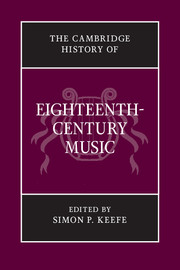Book contents
- Frontmatter
- PRELUDE
- PART I MUSIC FOR THE CHURCH
- 2 Catholic church music in Italy, and the Spanish and Portuguese Empires
- 3 Catholic sacred music in Austria
- 4 Catholic church music in France
- 5 Lutheran church music
- 6 Protestant church music in England and America
- INTERLUDE
- PART II MUSIC FOR THE THEATRE
- INTERLUDE
- PART III MUSIC FOR THE SALON AND CONCERT ROOM
- POSTLUDE
- Appendix I Chronology
- Appendix II Institutions in major European cities
- Appendix III Personalia
- Index
- References
2 - Catholic church music in Italy, and the Spanish and Portuguese Empires
from PART I - MUSIC FOR THE CHURCH
Published online by Cambridge University Press: 28 March 2011
- Frontmatter
- PRELUDE
- PART I MUSIC FOR THE CHURCH
- 2 Catholic church music in Italy, and the Spanish and Portuguese Empires
- 3 Catholic sacred music in Austria
- 4 Catholic church music in France
- 5 Lutheran church music
- 6 Protestant church music in England and America
- INTERLUDE
- PART II MUSIC FOR THE THEATRE
- INTERLUDE
- PART III MUSIC FOR THE SALON AND CONCERT ROOM
- POSTLUDE
- Appendix I Chronology
- Appendix II Institutions in major European cities
- Appendix III Personalia
- Index
- References
Summary
From J. S. Bach’s cantatas and Handel’s oratorios to Mozart’s operas and Haydn’s string quartets, the eighteenth century includes a great deal of familiar music, and many unknown works from the century are in styles that we intuitively understand. It is unsettling, then, to find large corners lacking illumination, including religious music composed in Italy, Spain, Portugal and Latin America. We encounter the occasional famous composer – usually a master of opera such as Alessandro Scarlatti or Giovanni Battista Pergolesi who also wrote sacred works – but most extant religious music was by local composers. The vast majority of these works were never printed, and many are extant only as unica in one archive. When we start to consider the number of archives at religious institutions in these countries, and that few have been investigated in detail, we begin to appreciate how much remains to be discovered about eighteenth-century sacred music in Roman Catholic countries.
Isolated pieces, such as Pergolesi’s Stabat Mater and Vivaldi’s Gloria, RV 589, are well known, but placing them in a vivid historical context is problematic because analogous compositions remain largely unstudied. There are useful dissertations and articles on a number of less-celebrated composers, but little about them in textbooks. John Walter Hill’s Baroque Music excavates new ground in his coverage of marginalized repertories, but his material on Latin church music in Italy for the second half of the seventeenth century through to the end of the Baroque is confined to six pages.
- Type
- Chapter
- Information
- The Cambridge History of Eighteenth-Century Music , pp. 27 - 58Publisher: Cambridge University PressPrint publication year: 2009
References
- 2
- Cited by



